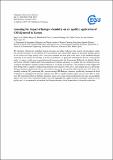Por favor, use este identificador para citar o enlazar a este item:
http://hdl.handle.net/10261/210038COMPARTIR / EXPORTAR:
 SHARE
BASE SHARE
BASE
|
|
| Visualizar otros formatos: MARC | Dublin Core | RDF | ORE | MODS | METS | DIDL | DATACITE | |

| Campo DC | Valor | Lengua/Idioma |
|---|---|---|
| dc.contributor.author | Li, Qinyi | - |
| dc.contributor.author | Borge, Rafael | - |
| dc.contributor.author | de la Paz, David | - |
| dc.contributor.author | Domingo, Jessica | - |
| dc.contributor.author | Cuevas, Carlos A. | - |
| dc.contributor.author | Saiz-Lopez, A. | - |
| dc.date.accessioned | 2020-05-02T17:12:09Z | - |
| dc.date.available | 2020-05-02T17:12:09Z | - |
| dc.date.issued | 2019-04-10 | - |
| dc.identifier.citation | European Geosciences Union General Assembly (2019) | - |
| dc.identifier.uri | http://hdl.handle.net/10261/210038 | - |
| dc.description | EGU General Assembly 2019,Vienna, Austria, 7–12 April 2019. -- https://www.geophysical-research-abstracts.net/egu2019.html. - Vol. 21, EGU2019-7300, 2019 | - |
| dc.description.abstract | The chemistry of halogens, including chlorine, bromine and iodine, influences the capacity of atmospheric oxida-tion and the formation of air pollution. Previous research have reported the impact of individual halogen species on air quality over large spatial scales. Very little attention has been paid to the effect of the combined halogen chemistry on air quality over Europe, in which air pollution is a persistent environmental hazard. In the present study, we adopt a widely-used regional chemical transport model, the Community Multiscale Air Quality Model- ing System (CMAQ), implemented with comprehensive halogen chemistry, to evaluate the role of halogens in the cycling of atmospheric oxidants and the production of secondary air pollutants. The simulation results suggest that the CMAQ model is capable of reproducing the levels and variations of O3, NO2, and halogen species over Europe. Halogen chemistry significantly affects the oxidative capacity by substantially enhancing the level of Cl atom, sub-stantially reducing NO3,decreasing HO2 and increasing OH. Halogen chemistry significantly decreases the levelof ambient O3 throughout the domain, and decreases NO2 in highly polluted region and increases NO2 in other area. The maximum effects of halogen chemistry occur over oceanic and coastal regions but some non-negligible impacts also occur over continental Europe. Our study highlights the significant effect of halogen chemistry on air quality and it is recommended to consider the halogen chemistry in the formulation of air quality regulation. | - |
| dc.language | eng | - |
| dc.publisher | European Geosciences Union | - |
| dc.relation.isversionof | Publisher's version | - |
| dc.rights | openAccess | - |
| dc.title | Assessing the impact of halogen chemistry on air quality: application of CMAQ model in Europe | - |
| dc.type | comunicación de congreso | - |
| dc.date.updated | 2020-05-02T17:12:09Z | - |
| dc.rights.license | http://creativecommons.org/licenses/by/4.0/ | - |
| dc.relation.csic | Sí | - |
| dc.type.coar | http://purl.org/coar/resource_type/c_5794 | es_ES |
| item.openairetype | comunicación de congreso | - |
| item.grantfulltext | open | - |
| item.cerifentitytype | Publications | - |
| item.openairecristype | http://purl.org/coar/resource_type/c_18cf | - |
| item.fulltext | With Fulltext | - |
| Aparece en las colecciones: | (IQF) Comunicaciones congresos | |
Ficheros en este ítem:
| Fichero | Descripción | Tamaño | Formato | |
|---|---|---|---|---|
| Assessing the impact.pdf | 36,32 kB | Adobe PDF |  Visualizar/Abrir |
CORE Recommender
Page view(s)
130
checked on 19-abr-2024
Download(s)
57
checked on 19-abr-2024
Google ScholarTM
Check
Este item está licenciado bajo una Licencia Creative Commons

